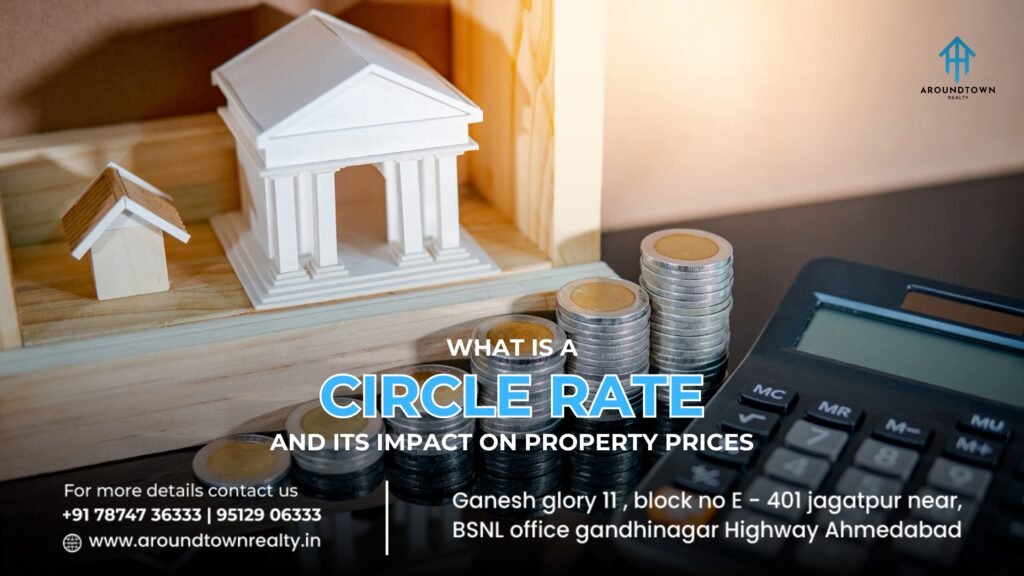When it comes to buying or selling property, one term that often pops up is Circle Rate. But what exactly is a circle rate, and how does it impact property prices? Whether you’re a first-time homebuyer, a seasoned investor, or just curious about the real estate market, understanding circle rates is crucial. This blog will dive deep into the concept of circle rate and its impact on property prices. By the end, you’ll have a clear understanding of why circle rates matter and how they can affect your real estate decisions.
Table of Contents
- What is a Circle Rate?
- How is Circle Rate Determined?
- Difference Between Circle Rate and Market Rate
- Why Are Circle Rates Important?
- How Circle Rates Impact Property Prices
- Factors Influencing Circle Rates
- Circle Rates Across Different Cities in India
- How to Check Circle Rates in Your Area
- Tips for Buyers and Sellers in a Circle Rate-Driven Market
What is a Circle Rate?
Circle rate, also known as guideline value or ready reckoner rate, is the minimum value at which a property transaction can be registered in a particular area. It is set by the state government and serves as a benchmark for property transactions. The primary purpose of circle rates is to prevent tax evasion and ensure transparency in real estate dealings.
For example, if you’re buying a property in Delhi, the circle rate will determine the minimum price at which the property can be legally registered, regardless of the actual transaction value. This rate varies depending on the location, type of property, and other factors.
Circle rates play a significant role in determining the stamp duty and registration charges you pay during a property transaction. If the transaction value is lower than the circle rate, the government will calculate taxes based on the circle rate, not the actual sale price.
How is Circle Rate Determined?
Circle rates are not arbitrary; they are carefully calculated by the state government based on several factors. These include:
- Location: Properties in prime areas like city centers or business districts have higher circle rates compared to those in suburban or rural areas.
- Infrastructure Development: Areas with better infrastructure, such as roads, metro connectivity, and schools, tend to have higher circle rates.
- Demand and Supply: High-demand areas often see an increase in circle rates due to the competitive real estate market.
- Type of Property: Residential, commercial, and industrial properties have different circle rates.
- Market Trends: The government periodically revises circle rates based on market trends and economic conditions.
For instance, if a new metro line is announced in a particular area, the circle rates in that locality are likely to increase due to the anticipated rise in property demand.
Difference Between Circle Rate and Market Rate
One of the most common points of confusion is the difference between circle rate and market rate. While both are related to property prices, they serve different purposes.
- Circle Rate: This is the minimum value set by the government for property registration. It is used to calculate stamp duty and registration charges.
- Market Rate: This is the actual price at which a property is bought or sold in the open market. It is determined by factors like demand, supply, location, and property condition.
In many cases, the market rate is higher than the circle rate, especially in high-demand areas. However, in some cases, the circle rate may be higher than the market rate, particularly in areas where property prices have declined.
Why Are Circle Rates Important?
Circle rates are more than just a government benchmark; they have a direct impact on both buyers and sellers. Here’s why they matter:
- Tax Calculation: Circle rates determine the minimum value for calculating stamp duty and registration charges. If the transaction value is lower than the circle rate, taxes will be calculated based on the circle rate.
- Preventing Tax Evasion: By setting a minimum value for property transactions, circle rates help curb black money and tax evasion in real estate.
- Loan Approval: Banks and financial institutions often use circle rates to determine the loan amount they can sanction for a property.
- Market Transparency: Circle rates provide a standardized value for properties, making it easier for buyers and sellers to negotiate fair prices.
How Circle Rates Impact Property Prices
Circle rates have a direct and indirect impact on property prices. Here’s how:
1. Direct Impact on Transaction Costs
When circle rates are high, the stamp duty and registration charges also increase. This can make property transactions more expensive for buyers. For example, if the circle rate in a particular area is ₹10,000 per square foot and the property size is 1,000 square feet, the minimum registration value will be ₹1 crore, regardless of the actual sale price.
2. Influence on Market Rates
In high-demand areas, market rates are often higher than circle rates. However, in areas where circle rates are revised upwards, property prices may also increase as sellers adjust their prices to align with the new rates.
3. Impact on Buyer Sentiment
When circle rates are increased, buyers may perceive the area as more valuable, leading to increased demand and higher property prices. Conversely, a decrease in circle rates may signal a decline in property values, affecting buyer sentiment.
4. Effect on Rental Yields
Higher circle rates can lead to higher property prices, which may reduce rental yields for investors. This is because the rental income may not increase proportionately with the property price.
YOU MIGHT ALSO READ THIS: How Rising Property Prices in Ahmedabad are Shaping Investment Strategies
Factors Influencing Circle Rates
Several factors influence the determination and revision of circle rates. These include:
- Location and Accessibility: Areas with better connectivity and amenities tend to have higher circle rates.
- Infrastructure Projects: New infrastructure projects like metro lines, highways, and airports can lead to an increase in circle rates.
- Economic Conditions: Inflation, interest rates, and overall economic growth can impact circle rates.
- Government Policies: Changes in government policies, such as tax reforms or housing schemes, can influence circle rates.
- Market Demand: High demand for properties in a particular area can lead to an increase in circle rates.
Circle Rates Across Different Cities in India
Circle rates vary significantly across different cities and even within different localities of the same city. Here’s a quick overview of circle rates in some major Indian cities:
1. Delhi
In Delhi, circle rates are among the highest in the country, especially in prime areas like South Delhi and Central Delhi. The rates range from ₹1.5 lakh to ₹3.5 lakh per square meter, depending on the locality.
2. Mumbai
Mumbai, being one of the most expensive real estate markets in India, has high circle rates. In areas like South Mumbai, circle rates can go up to ₹2 lakh per square meter.
3. Bangalore
In Bangalore, circle rates vary from ₹5,000 to ₹20,000 per square foot, depending on the location and type of property.
4. Chennai
Chennai’s circle rates range from ₹2,000 to ₹10,000 per square foot, with prime areas like Adyar and Anna Nagar commanding higher rates.
5. Hyderabad
Hyderabad has relatively lower circle rates compared to other metros, with rates ranging from ₹1,000 to ₹10,000 per square foot.
How to Check Circle Rates in Your Area
Checking circle rates in your area is simple and can be done online. Most state governments have portals where you can enter the property details and check the applicable circle rate. Here’s how you can do it:
- Visit the official website of your state’s revenue or registration department.
- Navigate to the circle rate or guideline value section.
- Enter the required details, such as the locality, type of property, and area.
- The portal will display the applicable circle rate for your property.
Tips for Buyers and Sellers in a Circle Rate-Driven Market
Navigating a circle rate-driven market can be challenging, but these tips can help:
For Buyers:
- Research Circle Rates: Always check the circle rates in your desired area before making a purchase.
- Negotiate Wisely: Use the circle rate as a benchmark to negotiate the property price.
- Plan for Additional Costs: Factor in stamp duty and registration charges based on the circle rate when budgeting for your purchase.
For Sellers:
- Price Your Property Right: Ensure your asking price aligns with the circle rate to attract genuine buyers.
- Highlight Location Advantages: If your property is in a high-circle-rate area, emphasize its value to potential buyers.
- Stay Updated: Keep track of revisions in circle rates to price your property competitively.
Conclusion: Make Informed Real Estate Decisions with AroundTown Realty
Understanding circle rates and their impact on property prices is essential for making informed real estate decisions. Whether you’re buying your dream home or investing in property, being aware of circle rates can help you navigate the market with confidence.
At AroundTown Realty, we’re committed to helping you make the best real estate decisions. Our team of experts is here to guide you through every step of the process, from understanding circle rates to finding the perfect property.
Ready to take the next step? Contact AroundTown Realty today and let us help you find the property of your dreams!
FAQs About Circle Rates
1. What happens if the transaction value is lower than the circle rate?
If the transaction value is lower than the circle rate, the government will calculate taxes based on the circle rate, not the actual sale price.
2. Can circle rates be revised?
Yes, circle rates are periodically revised by the state government based on market trends and economic conditions.
3. How do circle rates affect home loans?
Banks and financial institutions use circle rates to determine the loan amount they can sanction for a property.
4. Are circle rates the same across all cities?
No, circle rates vary across different cities and even within different localities of the same city.
5. How can I check the circle rate for my property?
You can check the circle rate for your property by visiting the official website of your state’s revenue or registration department.









